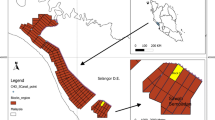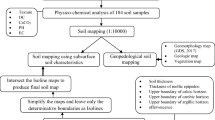Abstract
Conventional soil maps generally contain one or more soil types within a single soil polygon. But their geographic locations within the polygon are not specified. This restricts current applications of the maps in site-specific agricultural management and environmental modelling. We examined the utility of legacy pedon data for disaggregating soil polygons and the effectiveness of similarity-based prediction for making use of the under- or over-sampled legacy pedon data for the disaggregation. The method consisted of three steps. First, environmental similarities between the pedon sites and each location were computed based on soil formative environmental factors. Second, according to soil types of the pedon sites, the similarities were aggregated to derive similarity distribution for each soil type. Third, a hardening process was performed on the maps to allocate candidate soil types within the polygons. The study was conducted at the soil subgroup level in a semi-arid area situated in Manitoba, Canada. Based on 186 independent pedon sites, the evaluation of the disaggregated map of soil subgroups showed an overall accuracy of 67% and a Kappa statistic of 0.62. The map represented a better spatial pattern of soil subgroups in both detail and accuracy compared to a dominant soil subgroup map, which was commonly used in practice. Incorrect predictions mainly occurred in the agricultural plain area and the soil subgroups that are very similar in taxonomy, indicating that new environmental covariates need to be developed. We concluded that the combination of legacy pedon data with similarity-based prediction is an effective solution for soil polygon disaggregation.
Similar content being viewed by others
References
Arrouays D, Grundy M G, Hartemink A E, et al. 2014. GlobalSoilMap: toward a fine-resolution global grid of soil properties. Advances in Agronomy, 125: 93–134.
Ashtekar J M, Owens P R. 2013. Remembering knowledge: an expert knowledge based approach to digital soil mapping. Soil Horizons, 54(5), doi: 10.2136/sh13-01-0007.
Boettinger J L, Ramsey R D, Bodily J M, et al. 2008. Landsat spectral data for digital soil mapping. In: Hartemink A E, McBratney A B, MendonÇa-Santos M L. Digital Soil Mapping With Limited Data. Dordrecht: Springer, 193–202.
Boruvka L, Kozak J, Nemecek J, et al. 2002. New approaches to the exploitation of former soil survey data. In: 17th World Congress of Soil Science Bangkok. Thailand: IUSS.
Carré F, McBratney A B, Minasny B. 2007. Estimation and potential improvement of the quality of legacy soil samples for digital soil mapping. Geoderma, 141(1-2): 1–14.
Collard F, Kempen B, Heuvelink G B M, et al. 2014. Refining a reconnaissance soil map by calibrating regression models with data from the same map (Normandy, France). Geoderma Regional, 1: 21–30.
Cooperative Research Group on Chinese Soil Taxonomy. 2001. Keys to Chinese Soil Taxonomy (3rd ed.). Hefei: University of Science and Technology of China Press. (in Chinese)
Diem J E, Comrie A C. 2002. Predictive mapping of air pollution involving sparse spatial observations. Environmental Pollution, 119(1): 99–117.
Dobos E, Micheli E, Baumgardner M F, et al. 2000. Use of combined digital elevation model and satellite radiometric data for regional soil mapping. Geoderma, 97(3-4): 367–391.
Du F, Zhu A X, Band L E, et al. 2014. Soil property variation mapping through data mining of soil category maps. Hydrological Processes, 29(11): 2491–2503.
Geng X Y, Fraser W, VandenBygaart B, et al. 2010. Toward digital soil mapping in Canada: existing soil survey data and related expert knowledge. In: Boettinger J L, Howell D W, Moore A C, et al. Digital Soil Mapping: Bridging Research, Environmental Application, And Operation. Dordrecht: Springer, 325–335.
GlobalSoilMap Science Committee. 2015. GlobalSoilMap specifications-Tiered1 GlobalSoilMap products. Release 2.4. [2015-07-12]. http://globalsoilmap.net/specifications.
Grinand C, Arrouays D, Laroche B, et al. 2008. Extrapolating regional soil landscapes from an existing soil map: sampling intensity, validation procedures, and integration of spatial context. Geoderma, 143(1-2): 180–190.
Hijmans R J, Cameron S E, Parra J L, et al. 2005. Very high resolution interpolated climate surfaces for global land areas. International Journal of Climatology, 25(15): 1965–1978.
Holt A. 1999. Applying case-based reasoning techniques in GIS. International Journal of Geographical Information Science, 13(1): 9–25.
Huang W, Luo Y, Wang S Q, et al. 2016. Knowledge of soil-landscape model obtain from a soil map and mapping. Acta Pedologica Sinica, 53(1): 72–80. (in Chinese)
IUSS Working Group WRB. 2014. World Reference Base for Soil Resources 2014: International soil classification system for naming soils and creating legends for soil maps. World Soil Resources Reports FAO, Rome.
Ju W M, Chen J M. 2005. Distribution of soil carbon stocks in Canada’s forests and wetlands simulated based on drainage class, topography and remotely sensed vegetation parameters. Hydrological Processes, 19(1): 77–94.
Lagacherie P. 2008. Digital soil mapping: a state of the art. In: Hartemink A E, McBratney A B, MendonÇa-Santos M L. Digital Soil Mapping With Limited Data. Dordrecht: Springer, 3–14.
Landis J R, Koch G G. 1977. The measurement of observer agreement for categorical data. Biometrics, 33(1): 159–174.
Li Z, Huffman T, Zhang A N, et al. 2012. Spatially locating soil classes within complex soil polygons-mapping soil capability for agriculture in Saskatchewan Canada. Agriculture, Ecosystems and Environment, 152: 59–67.
MacMillan R A. 2004. Automated knowledge-based classification of landforms, soils and ecological spatial entities. Edmonton: LandMapper Environmental Solutions. [2009-03-03]. http://www.georeference.org/Forum/e32412F39303135342F31322D4 26F624D61634D696C6C69616E2E646F63/12-BobMacMillian.doc.
Malone B P, McBratney A B, Minasny B, et al. 2009. Mapping continuous depth functions of soil carbon storage and available water capacity. Geoderma, 154(1-2): 138–152.
McBratney A B. 1998. Some considerations on methods for spatially aggregating and disaggregating soil information. Nutrient Cycling in Agroecosystems, 50(1-3): 51–62.
McBratney A B, MendonÇa Santos M L, Minasny B. 2003. On digital soil mapping. Geoderma, 117(1-2): 3–52.
Minasny B, McBratney A B, Lark R M. 2008. Digital soil mapping technologies for countries with sparse data infrastructures. In: Hartemink A E, McBratney A B, MendonÇa-Santos M L. Digital Soil Mapping With Limited Data. Dordrecht: Springer, 15–30.
Moore I D, Gessler P E, Nielsen G A, et al. 1993. Soil attribute prediction using terrain analysis. Soil Science Society of America Journal, 57(2): 443–452.
Myers D E. 1994. Spatial interpolation: an overview. Geoderma, 62(1-3): 17–28.
Nauman T W, Thompson J A. 2014. Semi-automated disaggregation of conventional soil maps using knowledge driven data mining and classification trees. Geoderma, 213: 385–399.
Odeh I O A, McBratney A B. 2000. Using AVHRR images for spatial prediction of clay content in the lower Namoi Valley of eastern Australia. Geoderma, 97(3-4): 237–254.
Odgers N P, Sun W, McBratney A B, et al. 2014. Disaggregating and harmonising soil map units through resampled classification trees. Geoderma, 214-215: 91–100.
Park S J, van de Giesen N. 2004. Soil-landscape delineation to define spatial sampling domains for hillslope hydrology. Journal of Hydrology, 295(1-4): 28–46.
Penížek V, Boruvka L. 2004. Processing of conventional soil survey data using geostatistical methods. Plant Soil and Environment, 50(8): 352–357.
Pla A, López B, Gay P, et al. 2013. eXiT*CBR.v2: Distributed case-based reasoning tool for medical prognosis. Decision Support Systems, 54(3): 1499–1510.
Qin C Z, Lu Y J, Bao L L, et al. 2009. Simple digital terrain analysis software (SimDTA_1.0) and its application in fuzzy classification of slope positions. Journal of Geo-information Science, 11(6): 737–743. (in Chinese)
Sauchyn D J. 2001. Modeling the hydroclimatic disturbance of soil landscapes in the southern Canadian plains: the problems of scale and place. Environmental Monitoring and Assessment, 67(1-2): 277–291.
Schut P, Smith S, Fraser W, et al. 2011. Soil landscapes of Canada: building a national framework for environmental information. Geomatica, 65(3): 293–309.
Scull P, Franklin J, Chadwick O A. 2005. The application of classification tree analysis to soil type prediction in a desert landscape. Ecological Modelling, 181(1): 1–15.
Shary P A, Sharaya L S, Mitusov A V. 2002. Fundamental quantitative methods of land surface analysis. Geoderma, 107(1-2): 1–32.
Sim J, Wright C C. 2005. The Kappa statistic in reliability studies: use, interpretation, and sample size requirements. Physical Therapy, 85(3): 257–268.
Smith S, Bulmer C, Flager E, et al. 2010. Digital soil mapping at multiple scales in British Columbia, Canada. In: Program and Abstracts, 4th Global Workshop on Digital Soil Mapping Rome, Italy.
Soil Classification Working Group. 1998. The Canadian System of Soil Classification (3rd ed.). Ottawa: Agriculture and Agri-Food Canada Publication.
Soil Survey Staff. 2014. Keys to Soil Taxonomy (12th ed.). Washington: United States Department of Agriculture.
Subburayalu S K, Slater B K. 2012. Soil series mapping by knowledge discovery from an Ohio County Soil Map. Soil Science Society of America Journal, 77(4): 1254–1268.
Vandandorj S, Gantsetseg B, Boldgiv B. 2015. Spatial and temporal variability in vegetation cover of Mongolia and its implications. Journal of Arid Land, 7(4): 450–461.
Wang J F, Stein A, Gao B B, et al. 2012. A review of spatial sampling. Spatial Statistics, 2: 1–14.
Welsted J, Everitt J, Stadel C. 1996. The Geography of Manitoba: Its Land and Its People. Manitoba: University of Manitoba Press.
Yahiaoui I, Douaoui A, Zhang Q, et al. 2015. Soil salinity prediction in the Lower Cheliff plain (Algeria) based on remote sensing and topographic feature analysis. Journal of Arid Land, 7(6): 794–805.
Yang L, Jiao Y, Fahmy S, et al. 2011. Updating conventional soil maps through digital soil mapping. Soil Science Society of America Journal, 75(3): 1044–1053.
Zhu A X, Band L E, Dutton B, et al. 1996. Automated soil inference under fuzzy logic. Ecological Modelling, 90(2): 123–145.
Zhu A X, Hudson B, Burt J, et al. 2001. Soil mapping using GIS, expert knowledge, and fuzzy logic. Soil Science Society of America Journal, 65(5): 1463–1472.
Zhu A X, Liu J, Qin C Z, et al. 2010. Soil property mapping over large areas using sparse ad-hoc samples. In: 19th World Congress of Soil Science: Soil Solutions for a Changing World Brisbane, Australia.
Author information
Authors and Affiliations
Corresponding author
Rights and permissions
About this article
Cite this article
Liu, F., Geng, X., Zhu, Ax. et al. Soil polygon disaggregation through similarity-based prediction with legacy pedons. J. Arid Land 8, 760–772 (2016). https://doi.org/10.1007/s40333-016-0087-7
Received:
Revised:
Accepted:
Published:
Issue Date:
DOI: https://doi.org/10.1007/s40333-016-0087-7




